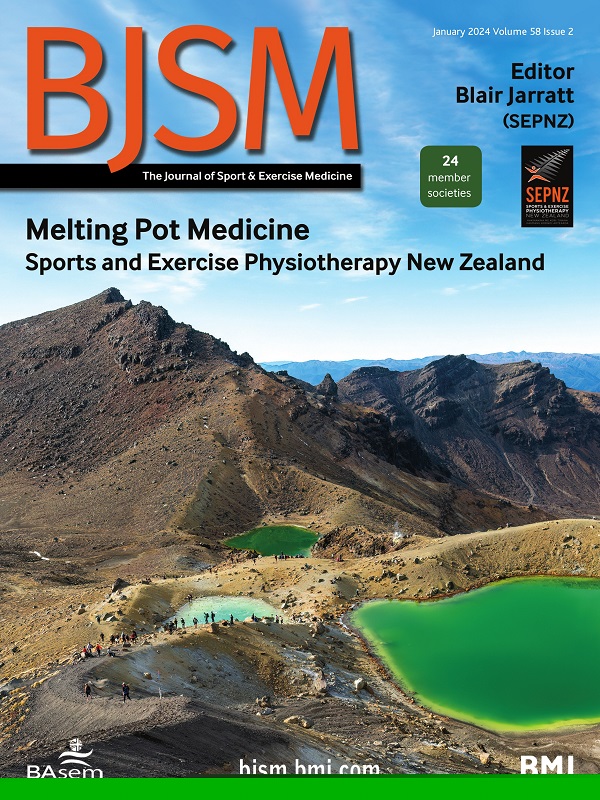利用创新促进适应性体育和残疾人体育
IF 16.2
1区 医学
Q1 SPORT SCIENCES
引用次数: 0
摘要
适应性运动和残疾人运动已成为一种强大的媒介,为残疾人运动员提供了赋权、康复和融入社会的平台随着我们越来越认识到它们的变革性影响,探索该领域的未来方向并激励创新变得非常重要。虽然精英残疾人运动可能受到更广泛的关注,但在娱乐水平上,适应性运动显著有助于控制慢性病和增强残疾人的功能独立性此外,它们可以改善心理健康,促进更强的认同感、使命感、社会联系和支持性社区;增强自尊,增加就业的可能性。1-3尽管适应性运动和辅助运动有明显的好处和扩展,但设施、设备和交通等障碍仍然存在。14此外,我们作为年轻临床医生的看法是,医学教育和培训在体育和残疾人方面的代表性仍然不足,在课程、课程内容、运动处方和研究机会方面存在差距。技术进步已经改变了适应性运动,为残疾人运动员提供了推动表现极限的新机会。专门的假肢、轮椅、可穿戴设备和辅助设备不仅改变了比赛,也改变了参与,通过提高运动效率,提高了各级运动员的精英水平和安全性。智能可穿戴设备最初是为健全运动员设计的,尽管需要进行调整以解决移动性和能量消耗的差异,但这些设备正越来越多地惠及残疾人运动员。虽然研究不断发展,但在准确衡量残疾人运动员的表现和装备效率方面仍然存在差距。现有的研究提供了见解……本文章由计算机程序翻译,如有差异,请以英文原文为准。
Harnessing innovation to advance adaptive and para sport
Adaptive and para sports have emerged as a powerful medium, giving para athletes a platform for empowerment, rehabilitation and social inclusion.1 As we increasingly appreciate their transformative impact, it is important to explore future directions in the field and incentivise innovation. While elite para sports may receive broader attention, at a recreational level, adaptive sports significantly aid in managing chronic conditions and enhancing functional independence for people living with disabilities.1 Furthermore, they can improve mental health, promoting a stronger sense of identity, purpose, social connections and supportive communities; enhance self-esteem and increase the likelihood of employment.1–3 Despite the clear benefits and expansion of adaptive and para sports, barriers such as inaccessible facilities, equipment and transportation persist.1 4 Additionally, our perception as young clinicians is that medical education and training continue to under-represent topics on sport and people living with disabilities, with gaps in the curricula, course content, exercise prescription and research opportunities.1 2 Technological advancements have transformed adaptive sports, offering new opportunities for para athletes to push performance boundaries. Specialised prostheses, wheelchairs, wearables and assistive devices have transformed not only competition but also participation, enhancing both elite-level achievements and safety for athletes across all levels through improved movement efficiency. ### Smart wearable devices Originally designed for able-bodied athletes, these are increasingly benefiting para athletes, despite the need for adaptations to address mobility and energy expenditure differences. While research has grown, gaps remain in accurately measuring para athletes’ performance and equipment effectiveness. Existing studies offer insights …
求助全文
通过发布文献求助,成功后即可免费获取论文全文。
去求助
来源期刊
CiteScore
27.10
自引率
4.90%
发文量
217
审稿时长
3-8 weeks
期刊介绍:
The British Journal of Sports Medicine (BJSM) is a dynamic platform that presents groundbreaking research, thought-provoking reviews, and meaningful discussions on sport and exercise medicine. Our focus encompasses various clinically-relevant aspects such as physiotherapy, physical therapy, and rehabilitation. With an aim to foster innovation, education, and knowledge translation, we strive to bridge the gap between research and practical implementation in the field. Our multi-media approach, including web, print, video, and audio resources, along with our active presence on social media, connects a global community of healthcare professionals dedicated to treating active individuals.

 求助内容:
求助内容: 应助结果提醒方式:
应助结果提醒方式:


